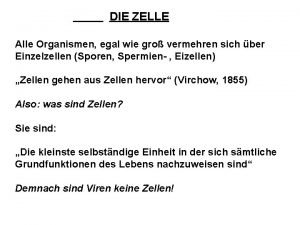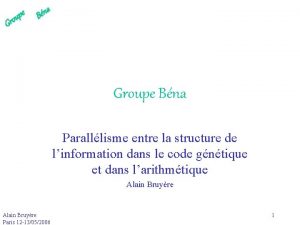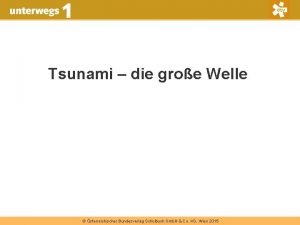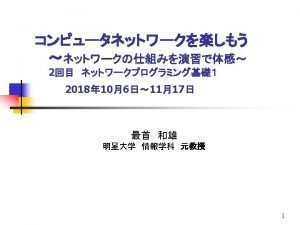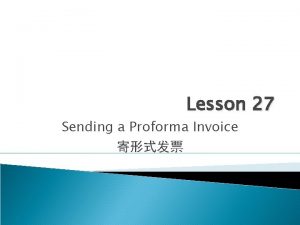gro Tutorial 3 Signals Declaring Signals Sending Signals










- Slides: 10

gro Tutorial 3

Signals • • • Declaring Signals Sending Signals Sensing Signals Absorbing Signals Reaction-Diffusion Bioprocessing example

Declaring Signals This line defines a signal called “ahl”. signal() takes two arguments: degradation rate diffusion rate include gro ahl : = signal(5, 0. 1); By itself, declaring a signal doesn’t do anything! It only defines a signal for use later in the program, either by a cell or the environment (main loop). Don’t set the diffusion rate too high or you will run into numerical integration errors.

Sending Signals with Cells include gro ahl : = signal(5, 0. 1); program signaler() : = { true : { emit_signal(ahl, 0. 2) } }; A cell can send a signal using the emit_signal() function. It has two arguments: The signal to use How much to release ecoli ( [], program signaler() ); These cells constantly emit signal. Try varying the parameters – what happens as you vary the diffusion and degradation rates of the signal, but keep their ratio the same?

Receiving Signals include gro ahl : = signal(5, 0. 1); k : = 2; // reporter scaling factor program signaler() : = { true : { emit_signal(ahl, 0. 2) } }; To have a cell sense a signal, use get_signal(). This function takes one argument: the signal to detect. program receiver() : = { gfp : = 0; rate(k*get_signal(ahl)) : { gfp : = gfp + 1 } }; ecoli ( [x: =50, theta: =3. 14/2], program signaler() ); ecoli ( [x: =-50], program receiver() ); This program has two cell types. The new cell type, “receiver”, produces gfp at a rate proportional to the signal it receives

Setting Environment Signals include gro ahl : = signal(5, 0. 1); k : = 10; // reporter scaling factor program receiver() : = { gfp : = 0; rate(k*get_signal(ahl)) : { gfp : = gfp + 1 } }; When defining a signal in main, use set_signal() takes four arguments: the signal to set x coordinate y coordinate the amount of signal to release program main() : = { true : { set_signal(ahl, 50, -50, 1) } }; ecoli ( [], program receiver() ); Coordinates in gro have the origin in the center of the screen, with x coordinates increasing from left to right and y coordinates increasing from top to bottom.

Absorbing Signals include gro ahl : = signal(5, 0. 1); k : = 2; // reporter scaling factor program signaler() : = { true : { emit_signal(ahl, 0. 2) } }; To have cells absorb a signal, use absorb_signal(), which takes two arguments: signal to absorb how much signal to absorb program receiver() : = { gfp : = 0; true : { absorb_signal(ahl, 0. 1) } rate(k*get_signal(ahl)) : { gfp : = gfp + 1 } }; ecoli ( [x: =50, theta: =3. 14/2], program signaler() ); ecoli ( [x: =-50], program receiver() ); This program is identical to the receiving signals program, but receiver cells eat up the signal. Absorption is useful both for accuracy and multicellular behaviors: cells that eat up a nutrient signal should absorb it, and signal removal is found in many natural multicellular signaling circuits.

Reaction-Diffusion include gro ahl : = signal(5, 0. 1); antiahl : = signal(1, 0. 1 ); reaction({ahl, antiahl}, {antiahl}, 10); reaction() defines how signals interact and takes 3 arguments: A list of reactants A list of products The reaction rate program signaler() : = { true : { emit_signal(ahl, 2) } }; program receiver() : = { gfp : = 0; rate(get_signal(ahl)) : { gfp : = gfp + 1 } }; Reaction-diffusion reactions are based on chemicals that can (1) react with each other (or themselves) and (2) diffuse. Basic pattern formation can be generated via reaction-diffusion alone. program main() : = { true: { foreach i in range 10 do { set_signal(antiahl, 0, (20040*i), 10) } end; } }; ecoli ( [x: =50, theta: =3. 14/2], program signaler() ); ecoli ( [x: =-50], program receiver() ); It can also be used for simpler behaviors: this program is identical to the receiving signals program, but with a line of “anti-ahl” signal that destroys ahl separating sending and receiving cells. How does this change the behavior of the receiver cells?

Example: Bioprocessing include gro Biomass is red, enzyme is green, food is blue In this simulation, food (and therefore growth) can only come from degradation of the biomass via an excreted enzyme Cell growth rate depends on nutrient availability Uneven distribution of non-diffusing feedstock set_theme ( bright_theme << [ signals : = { { 1, 0, 0 }, { 0, 1, 0 } , { 0, 0, 1 } } ] ); biomass : = signal(0, 0); enzyme : = signal(4, 0. 3); food : = signal(5, 0. 1); reaction({biomass, enzyme}, {food, enzyme}, 5); set("ecoli_growth_rate", 0. 0); program bioprocessor() : = { true : { set("ecoli_growth_rate", get_signal(food)), emit_signal(enzyme, 1) } }; program main() : = { t : = 0; true: { t : = t + dt } foreach i in range 2000 do { set_signal(biomass, rand(400), (rand(800)-400), 10) } end; }; ecoli ( [], program bioprocessor() ); Run the code! See what happens to the growing cell distribution by changing the diffusion rates.

Example: Bioprocessing Red, non-diffusing biomass particulates Green ‘enzyme’ that reacts with biomass to produce food Blue food that determines the growth rate




